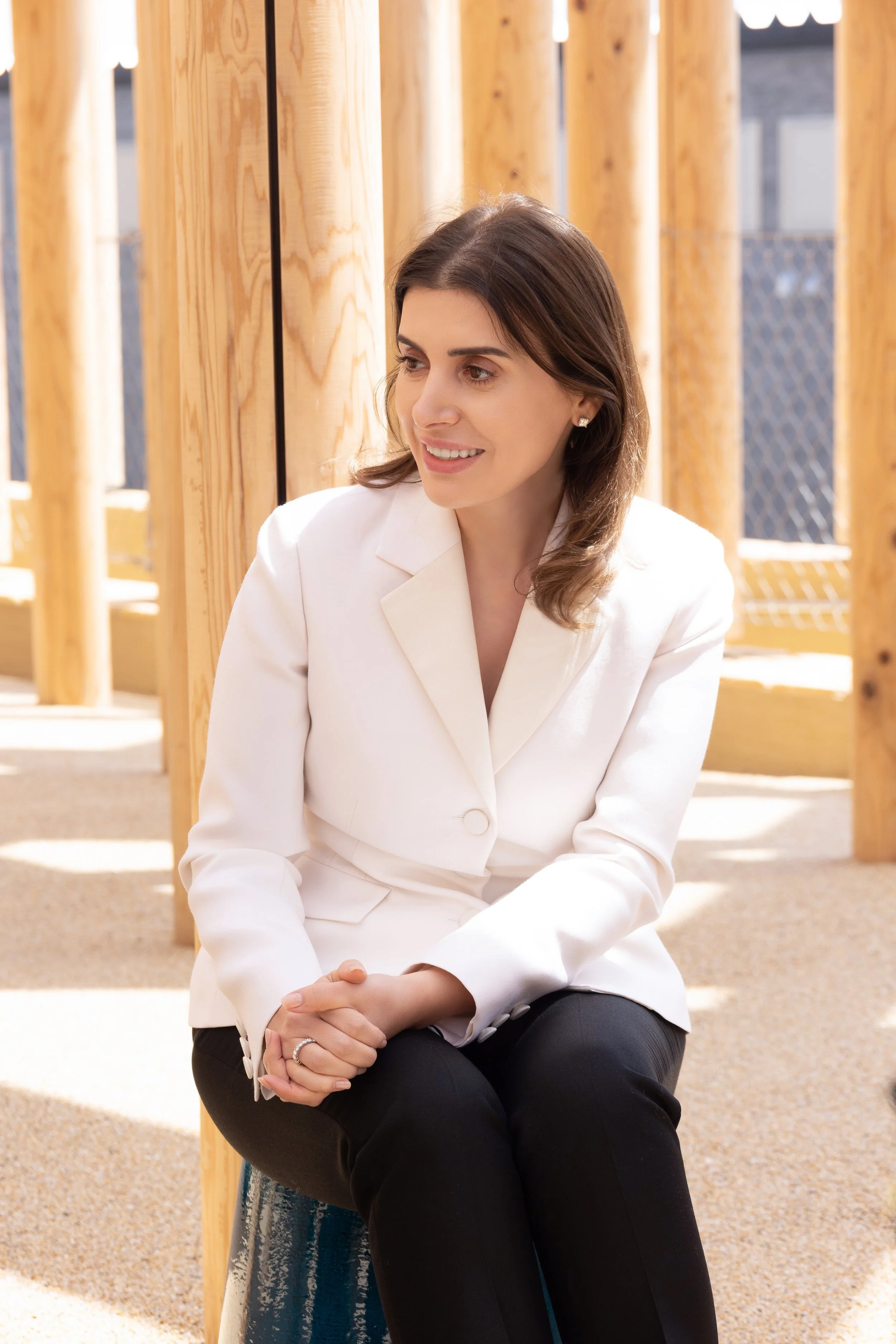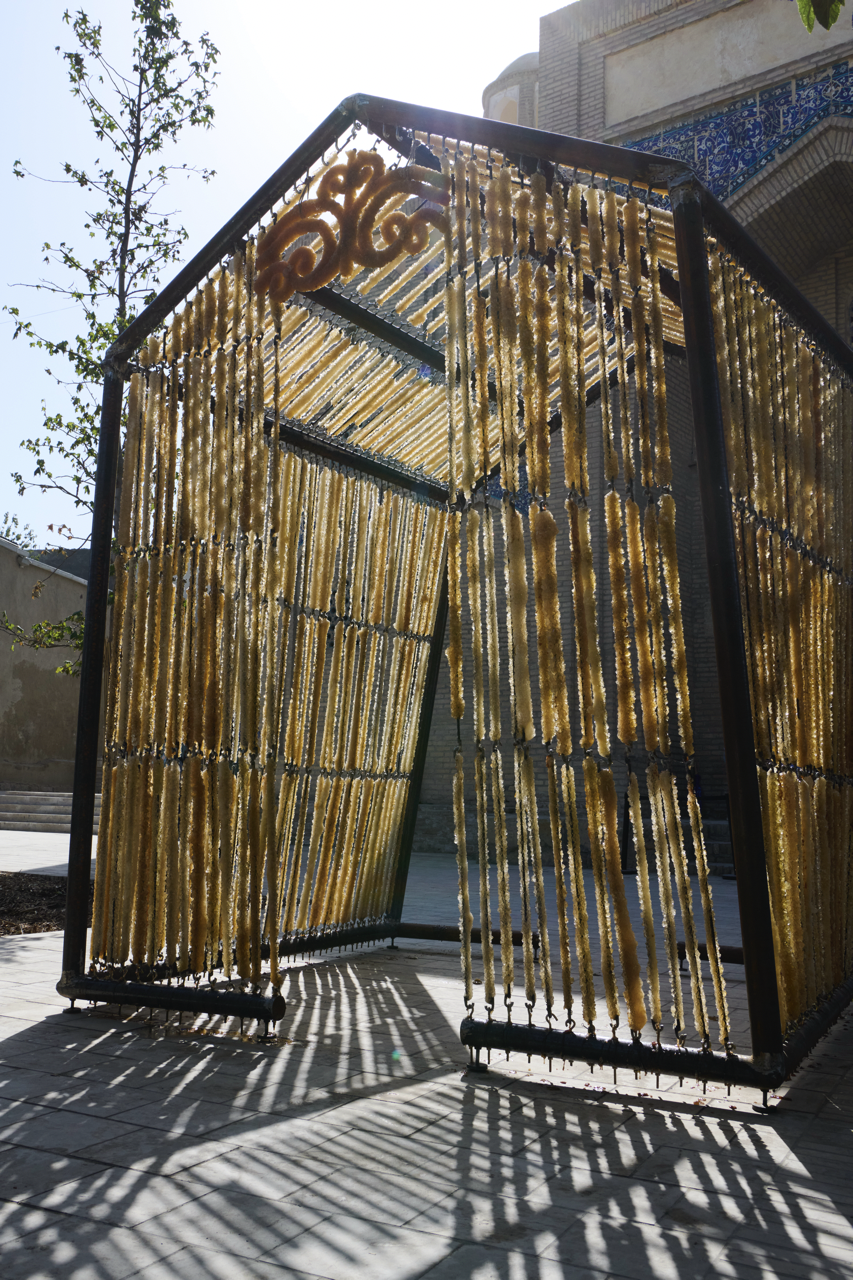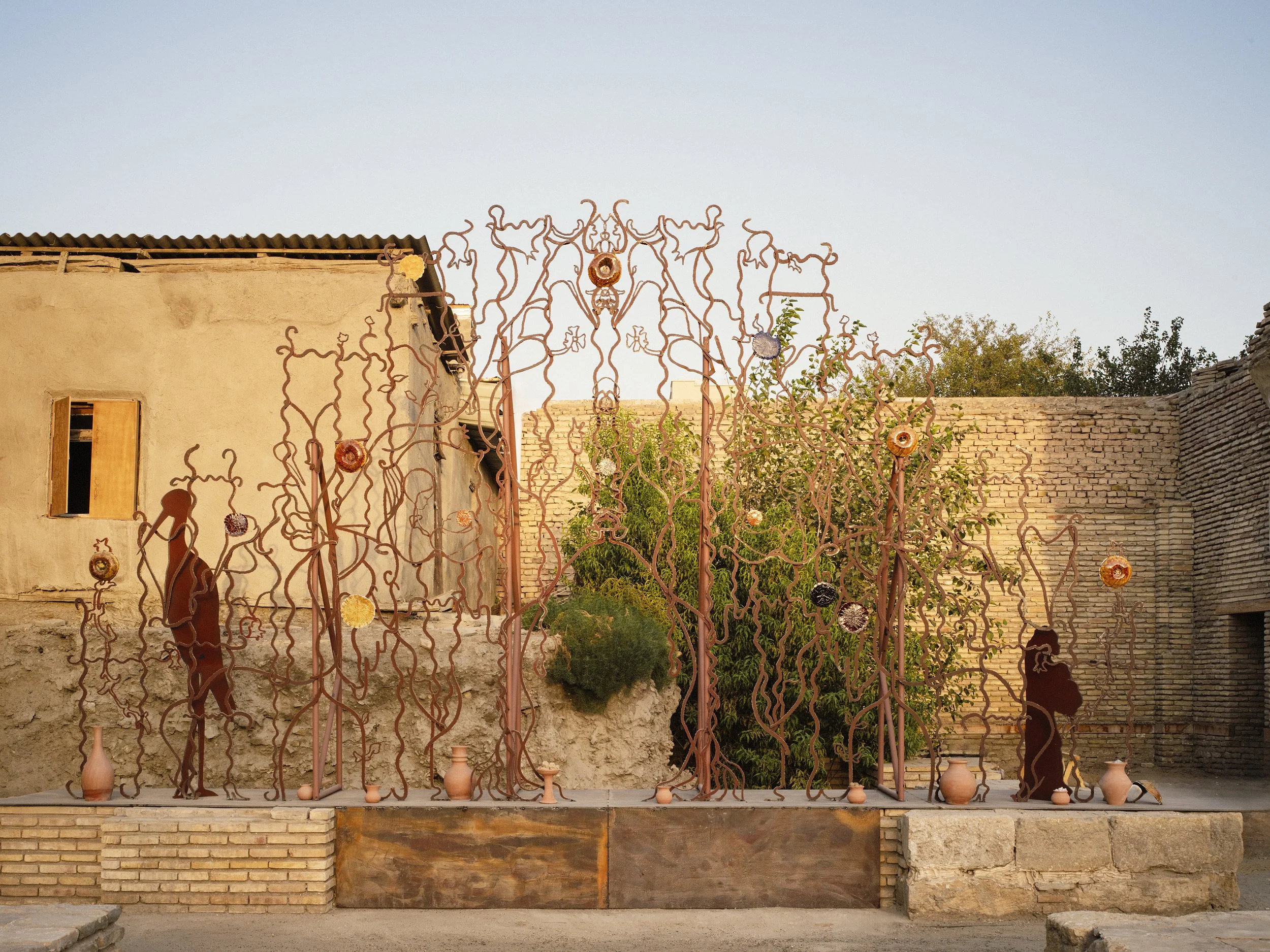Review of Bukhara Biennial
Successful debut of the first international art biennial in Uzbekistan
Laila Gohar (Egypt, United States) in collaboration with Ilkhom Shoyimkulov (Uzbekistan), Navat Uy, 2024-2025. Image courtesy of the Uzbekistan Art and Culture Development Foundation.
The Bukhara Biennial opened on 5 September in the city of Bukhara, a UNESCO Creative City, and will close later this week. It is commissioned by Gayane Umerova, Chairperson, The Uzbekistan Art and Cultural Development Foundation (ACDF), which preserves, promotes and nurtures Uzbekistan’s heritage, arts and culture. The biennial is curated by Artistic Director Diana Campbell, with the theme Recipes for Broken Hearts. It takes place in a 500-metre area of the old city of Bukhara, and features artworks presented in newly restored historical landmarks.
Altogether, there are 70 site-specific artworks and installations, involving more than 200 participants, from Uzbekistan and 38 other countries. All works were made in Uzbekistan with its artisans. “Bringing artists together with local masters was made possible thanks to the foundation’s support of the local craft community, and commitment to protect and nurture a culture-first vision for the country’s development,” says Umerova. “We hope that everyone who participates will be moved and inspired by Bukhara’s multi-layered history and the biennial as a new experience and creative platform for the Uzbek population.”
A week ago, I had the privilege of being on a tour of the biennial led by Assistant Curator Timur Zolotarev. What unfolded was a nearly three-hour immersive–and informative– experience walking through the public spaces, four interconnected caravanserais, Fathullajon, Ayozjon, Ahmadjon and Mirzo Ulugbek Tamakifurush, which originally provided accommodation and a market for travellers in the 18th and 19th century, as well as Gavukshon Madrasa, Khoja Kalon Mosque, Rashid Madrasa, and Magoki Attori, the oldest mosque in the city. As a first-time visitor to Bukhara, I enjoyed learning about deeply-rooted craft traditions, celebrated not only at the biennial, but also visible in the city’s shops, and skillfully iterated in the artisans’ studios, some right by the biennial sites.
Diana Campbell, Artistic Director, Bukhara Biennial. Photo by Nafisa Parpieva. Image courtesy of the Uzbekistan Art and Culture Development Foundation.
Gayane Umerova, Bukhara Biennial Commissioner and Chairperson Uzbekistan Art and Culture Development Foundation. Image courtesy of the Uzbekistan Art and Culture Development Foundation.
The close co-working relationships between the artists and the artisans are the raison d’être of the biennial. Their names are placed together on wooden heart-shaped stands that introduce the works, and can be flipped right to reveal the Uzbek version and left to reveal the English one, in an expression of the biennial’s place in the local and international art communities. “For me, many of the artists, artisans, and our team, Recipes for Broken Hearts has been about so much more than making artworks or making an exhibition; it is an attempt to heal from preconditioned painful and often outdated ways that we were told to think about art in hierarchical terms,” says Campbell. “We turned to collaboration as a tool to work together to dismantle these outdated frameworks and build new ones through our contributions to the inaugural Bukhara Biennial.”
Across multiple biennial sites, including the caravanserais, Gavkushon Madrasa and Rashid Madrasa, Bukharian artist Oyjon Khayrullaeva collaborated with mosaic masters Raxmon Toirov and Rauf Taxirov to show human organs, such as the heart, the lungs and the liver. She also worked with Bukharan grandmothers to pair these with tried and tested healing recipes, and explore the symbolisms of the organs in Uzbekistan today.
Oyjon Khayrullaeva (Uzbekistan) in collaboration with Raxmon Toirov and Rauf Taxirov (Uzbekistan), Eight Lives, 2024-2025. Image courtesy of the Uzbekistan Art and Culture Development Foundation.
Laila Gohar (Egypt, United States) in collaboration with Ilkhom Shoyimkulov (Uzbekistan), Navat Uy, 2024-2025.
Jahongir Bobokulov (Uzbekistan), in collaboration with Sanjar Kubaev (Uzbekistan), In Quest of Truth, 2024-2025.
I was intrigued and charmed by the artworks we encountered at every turn. Navat Uy is a house by Laila Gohar, composed of twisted Uzbek navat rock candy, which are made from crystallised grape syrup. It was created together with master navat maker Ilkhom Shoyimkulov. Twinkling in the sunshine, and delightful in the textures that are seen up close, it conjures up sweet childhood memories of discovering through taste.
Even as the biennial celebrates the craft traditions of Uzbekistan, contemporary materials and techniques are used, such as in In Quest of Truth (2024-2025) by Uzbek artist Jahongir Bobokulov, who spray-painted polyurethane foam to recreate the sunny walkways of Bukhara within the Govkushon Madrasah, a meta-immersive experience steeped both in history and the otherworldly.
Jenia Kim (Uzbekistan) in collaboration with Zilola Saidova, Zokhir Kamolov, Said Kamolov and Makhfuza Salimova (Uzbekistan), Home of Hope, 2024-2025.
On this trip, I learnt that Uzbekistan has the largest Korean diaspora in Central Asia. I particularly enjoyed the fine art debut of fashion designer Jenia Kim, who was born in the capital Tashkent, in a Soviet-Korean family. Home of Hope is in multiple locations. A part of it features life-sized stork scissors, created by blacksmiths Zokhir and Said Kamolov. The stork was a symbol of the city until it was driven out by a water crisis. In an optimistic gesture, Kim has reimagined them returning to witness the Bukhara Biennial. This extends her main project at the Rashid Madrasa, telling the stories of ordinary people in Uzbekistan, with images taken by photographer Zilola Saidova, which were then embroidered by Makhfuza Salimova. Like Khayrullaeva’s works, they are seen at multiple sites in the biennial, encouraging visitors to look out for them, and delight in finding them.
Play is a key aspect of the biennial. A good number of artworks are immersive, or interactive, and make the biennial an inviting experience. Children play freely in a caravanserai basement in A Corner for Everyone by Zi Kakhramonova, in collaboration with Lilian Cordell. It is modelled after conversation pits one might see in homes in the 1970s, with cushioned blocks that are inspired by toy construction sets.
In the background, Anna Lublina (USA/Germany) in collaboration with Feruza Asatova, Gulrukh Norkulova, Mehriniso Samieva and Roziya Sharipova (Uzbekistan), Bukhara Peace Agency, 2025. In the foreground, Zi Kakhramonova (Uzbekistan) in collaboration with Lilian Cordell (England), A Corner for Everyone, 2024-2025.
In the background, Jeong Kwan (South Korea) in collaboration with Koryo-saram community of Uzbekistan, Untitled, 2025, In the middle, Delcy Morelos (Colombia) in collaboration with Baxtiyor Akhmedov (Uzbekistan), La Sombra Terrestre [The Earth’s Shadow], 2024-2025. In the foreground, Antony Gormley (United Kingdom) in collaboration with Temur Jumaev (Uzbekistan), CLOSE, 2024-2025.
My favourite site, the Khoja Kalon Mosque, was originally built at the end of the 16th century. It is a sight to behold, sprawling across an expanse that draws the eye from one artwork to the next. They include Untitled by South Korean chef and Buddhist nun Jeong Kwan, fermenting kimchi in collaboration with the Koryo-saram community of Uzbekistan and La Sombra Terrestre [The Earth’s Shadow], a woven structure painted with a spice mixture of earth, desert sand, clay, cinnamon, cloves and turmeric by Colombian artist Delcy Morelos, in collaboration with Baxtiyor Akhmedov. There are also CLOSE, made up of a maze of sculptural mud bricks evoking bodies, by Antony Gormley (United Kingdom) in collaboration with local restorer Temur Jumaev and Arc of Arrival and an iron gate by Indonesia-based Japanese artist Kei Imazu, in collaboration with Pavel Makarov and Rustam Muzzaffarov, among other works. They co-exist harmoniously, and surprise visitors as they walk through the sand and discover them.
Kei Imazu (Japan, Indonesia), in collaboration with Pavel Makarov and Rustam Muzzaffarov (Uzbekistan), Arc of Arrival, 2024-2025.
Altogether, the contemporary works are well-integrated with the ruins, and as I walked and listened to Zolotarev, I appreciated the intention and care that had been put into the works, and the beauty before me. The curation was thoughtful, and struck a careful balance between showcasing works from local and international artists and between emerging and established ones. They offered restorative stories, or indeed, recipes for broken hearts.
Aside from the site-specific commissions, there are events, performances and culinary activations. For example, the House of Softness has hosted live masterclasses that address the heartbreak of dissipating traditions, such as one with Bukharan miniature painter Davlat Toshev. Closing the biennial is the Rice Cultures Festival, co-curated by Diana Campbell, Uzbek chef Bahriddin Chustiy and Marie Hélène Pereira. It celebrates rice as a common language of hospitality across cultures, and is held in tandem with a poetry programme curated by Katya García-Antón, built upon poems in Central. There is also a menu created by Jeong Kwan and Indian artist Subodh Gupta, using the kimchi that has been fermented on-site. For the final evening event, the Rice Cultures Feast features Bukharan palov from Uzbekistan, jollof rice from West Africa, paella from Spain and pulao from India, with a DJ set from Chef Tamsir Ndir and DJs from Sublimation Festival at Hauz.
Jazgul Madazimova (Kyrgyzstan), A Thousand Prayers, 2025, in collaboration with the women of Bukhara. Photo by Felix Odell. Image courtesy of the Uzbekistan Art and Culture Development Foundation.
The very last event of the biennial will be the movement of Jazgul Madazimova’s installation A Thousand Prayers at Khoja Kalon Mosque to Magoki Attori Mosque, in collaboration with female singers from the Bukhara Philharmonic Orchestra. The hundreds of headscarves from the women of Bukhara, making up a dragon-like monument, will be released one by one. The closing ritual will transform the work into visceral memory, etched into the minds of all who have witnessed this beautiful biennial.
Bukhara Biennial visual identity by Studio Manuel Raeder. Image courtesy of the Uzbekistan Art and Culture Development Foundation.
The guidebook forms yet another artwork for the biennial. It is rendered in blue hues by Bukharian illustrator Yunus Farmonov. Zolotarev shared that he communicated with the artist through multiple translations, since they did not speak the same language. The pages are a dream sequence of silhouettes and details that recall the works in real life. It is an apt memento of a daring and successful first-edition biennial. I am already looking forward to the next one.
The author was on a press trip to Samarkand, Bukhara and Tashkent, by invitation of the Art and Cultural Development Foundation of Uzbekistan.
For more information, click here to visit the Bukhara Biennial website.












